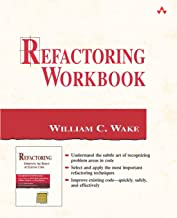Premise
“Refactoring improves through practice.”
The Refactoring Workbook contains exercises to help you assess and improve your ability to refactor (Java, but close enough for C# too). It’s available now from Amazon.com.
Thanks to those who reviewed the drafts! If you like the book, please consider posting a review at Amazon or elsewhere.
Also available: Refactoring in Ruby, with Kevin Rutherford. We did an interview with InformIT too.
Table of Contents
Preface
Chapter 1 – Roadmap
Section 1 – Smells Within Classes
Chapter 2 – The Refactoring Cycle
Chapter 3 – Measured Smells (Sample at java.net or at InformIT)
Interlude 1 – Smells and Refactorings
Chapter 4 – Names
Chapter 5 – Unnecessary Complexity
Interlude 2 – Inverses
Chapter 6 – Duplication
Chapter 7 – Conditional Logic
Interlude 3 – Design Patterns
Section 2 – Smells Between Classes
Chapter 8 – Data
Chapter 9 – Inheritance
Chapter 10 –Responsibility
Chapter 11 – Accommodating Change
Chapter 12 – Library Classes
Interlude 4 – Gen-A-Refactoring
Section 3 – Programs to Refactor
Chapter 13 – A Database Example
Chapter 14 – A Simple Game
Chapter 15 – Catalog
Chapter 16– Planning Game Simulator
Chapter 17– Where to Go From Here
Bibliography
Appendices
Appendix A. Selected Answers
Appendix B. Java Refactoring Tools
Appendix C. Inverses for Refactorings
Appendix D. Key Refactorings
Inside Cover – Smells and Refactorings
Reviews
“As an occasional teacher of undergraduate programming courses, I think this book is worth its weight in platinum.”–Gregory Wilson, Dr. Dobb’s Journal, July 2004. Page 82.
Author
William Wake (William.Wake@acm.org, xp123.com) is a programmer, coach, and author.
Source Code
File rwb.zip contains the source code for the longer examples in the book. (Updated Jan., 2014 to more modern Java and JUnit.)
Errata
- Page 63. The Elements of Programming Style is by Brian W. Kernighan and P.J. Plauger, not Kernighan and Pike. (Thanks to Mike Cohn for spotting this.)
- Page 121. The column names in the Offering table in the diagram don’t match up to the names in the code. Change the
getString()calls inOffering.find()to use columns"Name"and"DaysTimes". (Thanks to Glenn Boysko and Mohsen Akhavan for spotting this.) - Page 197. “hadMidScore” should be “hadMidRangeScore” in the code fragment:
boolean hadMidRangeScore = (score > 500)
(Thanks to Marco Isella for spotting this.)
Background Reading
- Refactoring: Improving the Design of Existing Code, Martin Fowler et al. Addison-Wesley, 1999.
- refactoring.com
More Resources
- The test-first challenge has you create a spreadsheet; there are plenty of refactorings you can do along the way.
- Mika Mäntylä has created a different taxonomy of smells. Joshua Kerievsky has another smell cheat sheet.
- Refactoring Demo Screencast demonstrates several ways to Extract Method.
